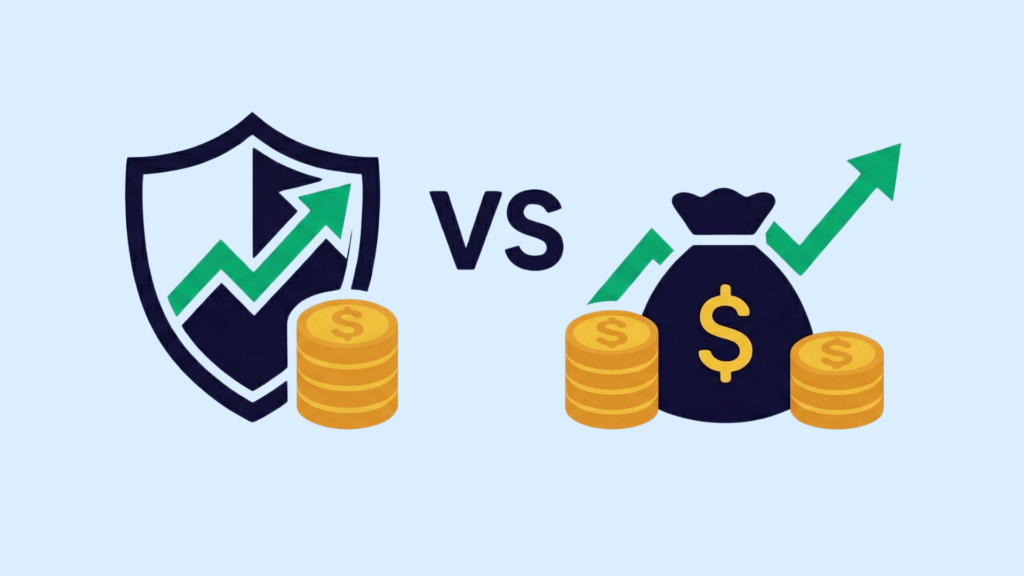XIRR (Extended Internal Rate of Return) is an important metric for accurately measuring returns on mutual fund investments, particularly when cash flows are irregular, such as with SIPs or withdrawals.
Unlike standard return metrics, XIRR accounts for the timing of each transaction, providing a precise annualised return rate. This article explores why XIRR is a powerful tool for measuring returns, especially for investments with irregular cash flows.
What is XIRR?
XIRR is your rate of return; it helps you evaluate the returns on your mutual fund investments.
Definition of XIRR
XIRR is a powerful tool for calculating investment returns. It’s particularly useful for mutual fund investments, where you’re likely to make multiple transactions at different times, like with a Systematic Investment Plan (SIP).
It considers all your cash flows – investments and redemptions – and their specific dates to give you a single annualised percentage representing your real-world performance.
Difference Between XIRR and IRR
While XIRR and IRR (Internal Rate of Return) measure investment profitability, they’re not interchangeable.
IRR assumes regular, evenly-spaced cash flows. This works well for investments with predictable patterns, but it fails to account for the realities of mutual fund investing.
XIRR, on the other hand, is designed to handle irregular cash flows. It considers the exact dates of your transactions, making it far more accurate for mutual fund investors who might be adding money at various times or making occasional withdrawals.
Why XIRR is Important for Mutual Fund Investors
Understanding XIRR is vital to clearly understanding your mutual fund performance. Here’s why:
- XIRR gives you the most precise measure of your returns, factoring in the timing and size of every transaction.
- If you’re using a Systematic Investment Plan, XIRR accurately captures the staggered nature of your investments.
- XIRR looks at your investments and accounts for any redemptions you’ve made, providing a complete picture of your fund’s performance.
- When trying to decide between mutual funds, XIRR allows you to make apples-to-apples comparisons, even if you’ve invested different amounts at different times.
How to Calculate XIRR?
Calculating XIRR might sound daunting, but it’s quite manageable with the right tools and approach. Here’s what you need to know:
Formula for XIRR
Here’s the formula breakdown for calculating XIRR:
=XIRR(values, dates, [guess])
Where:
- “values” is the series of cash flows (required)
- “dates” are the corresponding dates for each cash flow (required)
- “[guess]” is an optional initial estimate of the return rate (default is 10%)
Steps to Calculate XIRR
While it’s possible to calculate XIRR by hand, it’s not practical for most investors. Instead, here’s a general approach:
- Organise your data: List all your cash flows (investments and redemptions) with their corresponding dates.
- Use software: Employ a spreadsheet program like Microsoft Excel or Google Sheets.
- Apply the XIRR function: These programs have built-in XIRR functions that do the heavy lifting for you.
- Interpret the result: The output will be your annualised rate of return, expressed as a percentage.
Using Excel to Calculate XIRR
Excel is a powerful tool for calculating XIRR. Here’s a step-by-step guide:
- Open Excel and create two columns: one for dates and one for cash flows.
- Enter your transaction dates in the first column and cash flow in the second.
- In an empty cell, type the formula: =XIRR(cash_flow_range, date_range)
- Press Enter, and Excel will calculate your XIRR.
Example Calculation of XIRR
Assume you started an SIP of Rs 5,000 on 1 January 2023, and continue to invest the same amount for six months. And, as of 1 July 2023, your maturity amount is Rs. 31,000. In this case, here’s how to calculate XIRR in Excel:
- Set up your spreadsheet: Column G: Dates Column H: Cash flows.
- Enter the data:
- In cell H20, enter the XIRR formula:
- Press Enter. Excel will calculate your XIRR.
Importance of XIRR in Mutual Funds
XIRR can transform how you understand and manage your mutual fund investments. Let’s explore why it’s so important for investors like you.
Calculating SIP Returns with XIRR
XIRR is the gold standard for evaluating SIP returns. It accounts for the timing and amount of each investment, providing an accurate picture of your real-world performance.
Handling Irregular Cash Flows
XIRR excels at handling irregular cash flows, making it invaluable for real-world scenarios. It accurately calculates returns whether you’re making ad-hoc investments, partial withdrawals, or changing your contribution amounts over time.
Comparing Mutual Fund Performance Using XIRR
By providing a personalised performance metric based on your specific investment history, XIRR helps you see beyond advertised returns and understand which funds perform best for your unique financial journey.
Accurate Evaluation of Investment Performance
XIRR offers a comprehensive view of your investment performance by considering the amount and timing of each cash flow. It distils complex investment patterns into a single, annualised return rate, giving you a clear and accurate picture of your investment’s performance.
Consideration of Time Value of Money
By accounting for the time value of money, it acknowledges that funds invested earlier have more growth potential. This consideration results in a more nuanced and accurate representation of your investment’s performance over time, reflecting the true impact of your investment timing decisions.
Comparison of Investments with Different Cash Flow Patterns
XIRR enables fair comparisons between investments with vastly different cash flow patterns. This standardised approach allows you to evaluate various mutual funds or investment strategies equally, even if you’ve invested in them differently.
Assessment of Portfolio Diversification
By allowing you to calculate the overall return of your entire investment mix, it provides crucial insights into the effectiveness of your diversification strategy. This big-picture view is essential for understanding how well your various investments work together to meet your financial objectives.
Better Decision Making
XIRR helps you identify which investments are genuinely performing well, guides you in rebalancing your portfolio, and allows you to monitor progress towards your financial goals more accurately.
Practical Application with Mutual Funds
Now that you understand the importance of XIRR, let’s see how it works in real-world scenarios.
Practical Application in SIPs
You start a monthly SIP of ₹5,000 in a mutual fund on January 1, 2023. After 12 months, your investment value is ₹63,500. Here’s how to calculate XIRR:
- List your cash flows:
- 12 outflows of ₹5,000 each (January to December 2023)
- One inflow of ₹63,500 (final value on December 31, 2023)
- Use Excel’s XIRR function: =XIRR(cash_flows, dates)
- The result might be 11.25%
This 11.25% is your annualised return, considering the timing of each investment.
Interpreting XIRR Results
Understanding your XIRR result is crucial for making informed decisions:
- Compare to market benchmarks: Is your 11.25% return beating relevant market indices?
- Assess risk-adjusted returns: A higher XIRR might come with higher risk. Consider your risk tolerance.
- Evaluate against financial goals: Is this return rate sufficient to meet your long-term objectives?
- Consider external factors: Economic conditions, fund management changes, or market trends might influence future performance.
XIRR vs. CAGR: Which is Better?
When evaluating investment performance, you’ll often encounter two metrics: XIRR and CAGR. Let’s break down their differences and see when to use each.
XIRR and CAGR Definitions
XIRR is a more flexible metric that calculates the annualised return on investments, considering multiple cash flows at irregular intervals. It’s particularly useful for investments like mutual funds or SIPs, where money is invested or withdrawn at different times.
Conversely, CAGR represents an investment’s consistent annual growth rate over a specified period, assuming the profits are reinvested. It’s ideal for measuring the growth of a single investment or a portfolio with no intermediate cash flows.
When to Use XIRR
XIRR is your go-to metric when:
- You have multiple investments or withdrawals
- Cash flows are irregular (like SIPs or ad-hoc investments)
- You want to compare investments with different cash flow patterns
- You need to account for the timing of each transaction
Advantages of XIRR Over CAGR
XIRR offers several benefits:
- More accurate for real-world investing scenarios
- Accounts for the time value of money
- Provides a personalised return rate based on your specific investment pattern
- Allows fair comparison between different investment strategies
While CAGR is simpler, XIRR gives you a more nuanced and accurate picture of your investment performance.
Common Misconceptions About XIRR
As with any financial tool, there are some misconceptions about XIRR. Let’s clear them up to ensure you use this powerful metric effectively.
Complexity of XIRR Calculation
Many investors shy away from XIRR, thinking it’s too complex. The truth is:
- Modern tools make XIRR calculations simple
- Excel and Google Sheets have built-in XIRR functions
- Many investment apps and websites offer XIRR calculators
- You don’t need to understand the complex maths behind it to use it effectively
Applicability of XIRR
Some believe XIRR is only for mutual funds, but its use is much broader:
- Stock portfolios: Evaluate returns on stocks with dividend reinvestments
- Real estate: Analyse property investments with rental income and expenses
- Business investments: Assess returns on projects with irregular cash flows
- Personal finance: Track overall financial growth across various assets
The Bottom Line
Understanding and using XIRR in mutual fund investments is essential for accurately measuring returns, especially when dealing with irregular cash flows like SIPs or withdrawals. XIRR provides a precise annualised return rate, helping you assess the true performance of your investments over time.
Moreover, platforms such as the Appreciate trading app simplify this process by offering easy tools to calculate and compare XIRR across different mutual funds. Using Appreciate’s platform, you can make informed decisions, ensuring that your investment strategy aligns with your financial goals and maximises potential returns.
FAQs
What is XIRR in mutual funds?
XIRR (Extended Internal Rate of Return) is a method for calculating the annualised return on investments that involve multiple cash flows at different intervals. Compared to simpler metrics, it provides a more accurate picture of an investment’s performance.
How is XIRR different from IRR?
While IRR calculates the return for a series of cash flows occurring at regular intervals, XIRR accounts for irregular cash flows by assigning specific dates to each transaction. This makes XIRR more flexible and precise for investments like mutual funds or SIPs.
Can I calculate XIRR for SIP investments?
Yes, XIRR is particularly useful for calculating returns on SIP investments since it considers the varying dates and amounts of each instalment. This gives you a true annualised return that reflects the timing of your investments.
How do I use Excel to calculate XIRR?
In Excel, you can calculate XIRR by listing all your cash flows with corresponding dates and using the XIRR function. This will give you an annualised return rate, considering the irregularity of your investments and withdrawals.
Why is XIRR important for measuring mutual fund returns?
XIRR is crucial because it accurately measures returns for investments with irregular cash flows, such as SIPs or withdrawals. It helps investors see the true performance of their mutual funds over time.
What are the advantages of using XIRR over CAGR?
XIRR offers a more precise calculation when dealing with investments with multiple or irregular cash flows, whereas CAGR assumes a consistent growth rate without considering these variations. This makes XIRR a better tool for assessing the actual performance of such investments.
Is XIRR applicable only to mutual funds?
No, XIRR can be applied to any investment that involves irregular cash flows, including stocks, bonds, or real estate. It’s a versatile tool for measuring various investments’ annualised returns.
How can XIRR help in making investment decisions?
XIRR provides a clearer picture of an investment’s performance, allowing you to compare different investments accurately. By understanding your true annualised returns, you can make better-informed decisions to optimise your portfolio.























